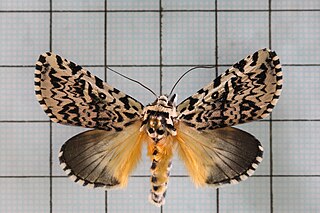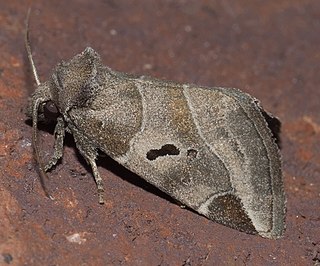
Coccothrinax is a genus of palms in the family Arecaceae. There are more than 50 species described in the genus, plus many synonyms and subspecies. A new species was described as recently as 2017. Many Coccothrinax produce thatch. In Spanish-speaking countries, guano is a common name applied to Coccothrinax palms. The species are native throughout the Caribbean, the Bahamas, extreme southern Florida and southeastern Mexico, but most of the species are known only from Cuba.

Deltote deceptoria, the pretty marbled, is a moth of the family Noctuidae. The species was first described by Giovanni Antonio Scopoli in his 1763 Entomologia Carniolica. It is found in southern and central Europe.

Lithacodia uncula, the silver hook, is a moth of the family Noctuidae. The species was first described by Carl Alexander Clerck in 1759. It is found in the Palearctic realm.

Zanclognatha is a genus of litter moths of the family Erebidae. The genus was erected by Julius Lederer in 1857.
Koyaga is a genus of moths of the family Noctuidae. The genus was described by Ueda in 1984.

Trichosea champa is a moth of the family Noctuidae first described by Frederic Moore in 1879. It is found in the Himalayas, north-east India, Sri Lanka, China, Taiwan, Japan, and Russia.

Stiriinae is a subfamily of owlet moths in the family Noctuidae. There are more than 20 genera and 130 described species in Stiriinae.

Koyaga virescens is a moth of the family Noctuidae first described by Shigero Sugi in 1958. It is found in Japan and Taiwan.

Pseudodeltote formosana is a species of moth of the family Noctuidae first described by George Hampson in 1910. It is found in Taiwan. The length of the forewings is 12–14 mm. The forewings are dark brown suffused with olive green and the hindwings are white, sparsely sprinkled with dark brown.
Pseudodeltote brunnea is a species of moth of the family Noctuidae first described by John Henry Leech in 1889. It is found on the Japanese islands of Hokkaido, Honshu, Shikoku and Kyushu.

Pseudodeltote coenia is a species of moth of the family Noctuidae first described by Charles Swinhoe in 1901. It is found in Taiwan.
Protodeltote wiscotti is a species of moth of the family Noctuidae first described by Otto Staudinger in 1888. It is found in the Russian Far East and Japan.
Protodeltote distinguenda is a species of moth of the family Noctuidae first described by Otto Staudinger in 1888. It is found in Korea, Taiwan and Japan.
Protodeltote inexpectata is a species of moth of the family Noctuidae first described by Ueda in 1984. It is found in Japan.
Micardia pulchra is a species of moth of the family Noctuidae first described by Arthur Gardiner Butler in 1878. It is found in Korea and Japan.
Koyaga falsa is a species of moth of the family Noctuidae first described by Arthur Gardiner Butler in 1885. It is found in China, Korea and Japan.
Koyaga numisma is a species of moth of the family Noctuidae first described by Otto Staudinger in 1888. It is found in Russia, China, Korea and Japan.
Koyaga senex is a species of moth of the family Noctuidae first described by Arthur Gardiner Butler in 1881. It is found in Japan.

Micardia pulcherrima is a species of moth of the family Noctuidae. It is found in Bhutan, China (Tibet) and India.









